Modeling the Census Tract Level Housing Vacancy Rate with the Jilin1-03 Satellite and Other Geospatial Data
Abstract
1. Introduction
2. Study Area and Data
2.1. Study Area
2.2. The Jilin1-03 Satellite Night-Time Image
2.3. Other Geospatial Data
3. Methodology
3.1. Pre-Processing of the Jilin1-03 Satellite Night-Time Image
3.2. Extracting Variables from the Multi-Source Data
3.3. Establishing an HVR Regression Model with Multivariate Explanatory Variables
4. Results
4.1. Results of the HVR Estimation Regression Model
4.2. Distribution of Estimated HVR
5. Discussion
5.1. Significant Variable Analysis of the Regression Models
5.2. Improvements, Limitations, and Further Implications
6. Conclusions
Author Contributions
Acknowledgments
Conflicts of Interest
References
- Häußermann, H.; Siebel, W. Die Schrumpfende Stadt und die Stadtsoziologie; VS Verlag für Sozialwissenschaften: Wiesbaden, Germany, 1988; pp. 78–94. [Google Scholar]
- Martinez-Fernandez, C.; Audirac, I.; Fol, S.; Cunningham-Sabot, E. Shrinking Cities: Urban Challenges of Globalization. Int. J. Urban Reg. Res. 2012, 36, 213–225. [Google Scholar] [CrossRef] [PubMed]
- Pallagst, K.; Aber, J.; Audirac, I.; Cunningham-Sabot, E.; Fol, S.; Martinez-Fernandez, C.; Moraes, S.; Mulligan, H.; Vargas-Hernandez, J.; Wiechmann, T.; Wu, T. The Future of Shrinking Cities: Problems, Patterns and Strategies of Urban Transformation in a Global Context; Sae Technical Papers; University of California: Oakland, CA, USA, 2009. [Google Scholar]
- Nassauer, J.I.; Raskin, J. Urban vacancy and land use legacies: A frontier for urban ecological research, design, and planning. Landsc. Urban Plan. 2014, 125, 245–253. [Google Scholar] [CrossRef]
- Haase, D.; Haase, A.; Rink, D. Conceptualizing the nexus between urban shrinkage and ecosystem services. Landsc. Urban Plan. 2014, 132, 159–169. [Google Scholar] [CrossRef]
- Rall, E.L.; Haase, D. Creative intervention in a dynamic city: A sustainability assessment of an interim use strategy for brownfields in Leipzig, Germany. Landsc. Urban Plan. 2011, 100, 189–201. [Google Scholar] [CrossRef]
- Logan, J. Greening the Rust Belt: A Green Infrastructure Model for Right Sizing America’s Shrinking Cities. J. Am. Plan. Assoc. 2008, 74, 451–466. [Google Scholar]
- Silverman, R.M.; Yin, L.I.; Patterson, K.L. Dawn of the Dead City: An Exploratory Analysis of Vacant Addresses in Buffalo, NY 2008–2010. J. Urban Affairs 2013, 35, 131–152. [Google Scholar] [CrossRef]
- Huuhka, S. Vacant residential buildings as potential reserves: A geographical and statistical study. Build. Res. Inf. 2016, 44, 816–839. [Google Scholar] [CrossRef]
- Schilling, J. Blueprint Buffalo—Using Green Infrastructure to Reclaim America’s Shrinking Cities. In The Future of Shrinking Cities: Problems, Patterns and Strategies of Urban Transformation in a Global Context; The Shrinking Cities International Research Network: Leipzig, Germany, 2009. [Google Scholar]
- Huuhka, S.; Lahdensivu, J. Statistical and geographical study on demolished buildings. Build. Res. Inf. 2016, 44, 73–96. [Google Scholar] [CrossRef]
- Accordino, J.; Johnson, G.T. Addressing the Vacant and Abandoned Property Problem. J. Urban Affairs 2000, 22, 301–315. [Google Scholar] [CrossRef]
- Bauer, M.E.; Yuan, F.; Sawaya, K.E. Multi-temporal landsat image classification and change analysis of land cover in the twin cities (minnesota) metropolitan area. Remote Sens. Environ. 2005, 98, 317–328. [Google Scholar]
- Sleeter, B.M.; Sohl, T.L.; Loveland, T.R.; Auch, R.F.; Acevedo, W.; Drummond, M.A.; Sayler, K.L.; Stehman, S.V. Land-cover change in the conterminous United States from 1973 to 2000. Glob. Environ. Chang. 2013, 23, 733–748. [Google Scholar] [CrossRef]
- Wu, S.-S.; Qiu, X.; Wang, L. Using Semi-variance Image Texture Statistics to Model Population Densities. Am. Cartogr. 2006, 33, 127–140. [Google Scholar] [CrossRef]
- Wu, S.-S.; Qiu, X.; Wang, L. Population Estimation Methods in GIS and Remote Sensing: A Review. Map. Sci. Remote Sens. 2005, 42, 17. [Google Scholar] [CrossRef]
- Silván-Cárdenas Jose, L.; Wang, L.; Rogerson, P.; Wu, C.S.; Feng, T.T.; Kamphaus, B.D. Assessing fine-spatial-resolution remote sensing for small-area population estimation. Int. J. Remote Sens. 2010, 31, 5605–5634. [Google Scholar] [CrossRef]
- Deng, C.; Wu, C.; Wang, L. Improving the housing-unit method for small-area population estimation using remote-sensing and GIS information. Int. J. Remote Sens. 2010, 31, 5673–5688. [Google Scholar] [CrossRef]
- Pawe, C.K.; Saikia, A. Unplanned urban growth: Land use/land cover change in the Guwahati Metropolitan Area, India. Geografisk Tidskrift 2018, 118, 88–100. [Google Scholar] [CrossRef]
- Dewan, A.M.; Yamaguchi, Y. Land use and land cover change in Greater Dhaka, Bangladesh: Using remote sensing to promote sustainable urbanization. Appl. Geogr. 2009, 29, 390–401. [Google Scholar] [CrossRef]
- Acheampong, M.; Yu, Q.; Enomah, L.D.; Anchang, J.; Eduful, M. Land use/cover change in Ghana’s oil city: Assessing the impact of neoliberal economic policies and implications for sustainable fevelopment goal number one—A remote sensing and GIS approach. Land Use Policy 2018, 73, 373–384. [Google Scholar] [CrossRef]
- Weinberg, D.H. How the United States measures well-being in household surveys. J. Off. Stat. Stockholm 2006, 22, 113. [Google Scholar]
- Lu, H.; Lv, J. The research of Wuhan commercial housing vacancy rate. In Proceedings of the 2012 International Conference on Information Management, Innovation Management and Industrial Engineering, Sanya, China, 20–21 October 2012. [Google Scholar]
- Rosen, K.T.; Smith, L.B. The Price-Adjustment Process for Rental Housing and the Natural Vacancy Rate. Am. Econ. Rev. 1983, 73, 779–786. [Google Scholar]
- Bentley, G.C.; Mccutcheon, P.; Cromley, R.G.; Hanink, D.M. Race, class, unemployment, and housing vacancies in Detroit: An empirical analysis. Urban Geogr. 2015, 37, 1–16. [Google Scholar] [CrossRef]
- Wang, H.; Chang, C.J. Simulation of housing market dynamics: Amenity distribution and housing vacancy. In Proceedings of the 2013 Winter Simulations Conference (WSC), Washington, DC, USA, 8–11 December 2013; pp. 2749–2770. [Google Scholar]
- Wang, L.; Shi, C.; Diao, C.; Ji, W.; Yin, D. A survey of methods incorporating spatial information in image classification and spectral unmixing. Int. J. Remote Sens. 2016, 37, 3870–3910. [Google Scholar] [CrossRef]
- Emmanuel, R. Urban vegetational change as an indicator of demographic trends in cities: The case of Detroit. Environ. Plan. B 1997, 24, 415–426. [Google Scholar] [CrossRef]
- Ryznar, R.M.; Wagner, T.W. Using Remotely Sensed Imagery to Detect Urban Change: Viewing Detroit from Space. J. Am. Plan. Assoc. 2001, 67, 327–336. [Google Scholar] [CrossRef]
- Deng, C.; Ma, J. Viewing urban decay from the sky: A multi-scale analysis of residential vacancy in a shrinking U.S. city. Landsc. Urban Plan. 2015, 141, 88–99. [Google Scholar] [CrossRef]
- Yao, Y.; Li, Y. House vacancy at urban areas in China with nocturnal light data of DMSP-OLS. In Proceedings of the 2011 IEEE International Conference on Spatial Data Mining and Geographical Knowledge Services, Fuzhou, China, 29 June–1 July 2011. [Google Scholar]
- Chen, Z.; Yu, B.; Hu, Y.; Huang, C.; Shi, K.; Wu, J. Estimating House Vacancy Rate in Metropolitan Areas Using NPP-VIIRS Nighttime Light Composite Data. IEEE J. Sel. Top. Appl. Earth Obs. Remote Sens. 2017, 8, 2188–2197. [Google Scholar] [CrossRef]
- Kyba, C.C.M.; Garz, S.; Kuechly, H.; de Miguel, A.S.; Zamorano, J.; Fischer, J.; Hölker, F. High-Resolution Imagery of Earth at Night: New Sources, Opportunities and Challenges. Remote Sens. 2015, 7, 1–23. [Google Scholar] [CrossRef]
- Hillger, D.; Kopp, T.; Lee, T.; Lindsey, D.; Seaman, C.; Miller, S.; Solbrig, J.; Kidder, S.; Bachmeier, S.; Jasmin, T.; Rink, T. First-Light imagery from SuomiNPP VIIRS. Bull. Am. Meteorol. Soc. 2013, 94, 1019–1029. [Google Scholar] [CrossRef]
- Elvidge, C.D.; Sutton, P.C.; Ghosh, T.; Tuttle, B.T.; Baugh, K.E.; Bhaduri, B.L.; Bright, E.A. A global poverty map derived from satellite data. Comput. Geosci. 2009, 35, 1652–1660. [Google Scholar] [CrossRef]
- Ghosh, T.; Anderson, S.J.; Elvidge, C.D.; Sutton, P.C. Using Nighttime Satellite Imagery as a Proxy Measure of Human Well-Being. Sustainability 2013, 5, 4988–5019. [Google Scholar] [CrossRef]
- Ghosh, T. Estimation of Mexico’s Informal Economy and Remittances Using Nighttime Imagery. Remote Sens. 2009, 1, 418–444. [Google Scholar] [CrossRef]
- Doll, C.N.H.; Muller, J.P.; Morley, J.G. Mapping regional economic activity from night-time light satellite imagery. Ecol. Econ. 2006, 57, 75–92. [Google Scholar] [CrossRef]
- Zhou, Y.; Ma, T.; Zhou, C.; Xu, T. Nighttime Light Derived Assessment of Regional Inequality of Socioeconomic Development in China. Remote Sens. 2015, 7, 1242–1262. [Google Scholar] [CrossRef]
- Wu, R.; Yang, D.; Dong, J.; Yang, D.; Dong, J.; Zhang, L.; Xia, F. Regional inequality in China based on NPP-VIIRS night-time light imagery. Remote Sens. 2018, 10, 240. [Google Scholar] [CrossRef]
- Doll, C.N.H. CIESIN Thematic Guide to Night-Time Light Remote Sensing and Its Applications; Center for International Earth Science Information Network (CIESIN), Columbia University: Palisades, NY, USA, 2008. [Google Scholar]
- Yue, W.; Gao, J.; Yang, X. Estimation of Gross Domestic Product Using Multi-Sensor Remote Sensing Data: A Case Study in Zhejiang Province, East China. Remote Sens. 2014, 6, 7260–7275. [Google Scholar] [CrossRef]
- Qi, K.; Hu, Y.; Cheng, C.; Chen, B. Transferability of Economy Estimation Based on DMSP/OLS Night-Time Light. Remote Sens. 2017, 9, 786. [Google Scholar] [CrossRef]
- Zhu, X.; Ma, M.; Yang, H.; Bo, C. Modeling the Spatiotemporal Dynamics of Gross Domestic Product in China Using Extended Temporal Coverage Nighttime Light Data. Remote Sens. 2017, 9, 626. [Google Scholar] [CrossRef]
- Doll, C.N.H.; Muller, J.P.; Elvidge, C.D. Nighttime Imagery as a Tool for Global Mapping of Socioeconomic Parameters and Greenhouse Gas Emissions. Ambio 2000, 29, 157–162. [Google Scholar] [CrossRef]
- Elvidge, C.D.; Baugh, K.E.; Kihn, E.A.; Kroehl, H.W.; Davis, E.R.; Davis, C.W. Relation between satellite observed visible-near infrared emissions, population, economic activity and electric power consumption. Int. J. Remote Sens. 1997, 18, 1373–1379. [Google Scholar] [CrossRef]
- Letu, H.; Hara, M.; Yagi, H.; Naoki, K.; Tana, G.; Nishio, F.; Shuhei, O. Estimating energy consumption from night-time DMPS/OLS imagery after correcting for saturation effects. Int. J. Remote Sens. 2010, 31, 4443–4458. [Google Scholar] [CrossRef]
- Amaral, S.; Câmara, G.; Monteiro, A.M.V.; Quintanilha, J.A.; Elvidge, C.D. Estimating population and energy consumption in Brazilian Amazonia using DMSP night-time satellite data. Comput. Environ. Urban Syst. 2005, 29, 179–195. [Google Scholar] [CrossRef]
- Welch, R.; Zupko, S. Urbanized area energy utilization patterns from DMSP data. Photogramm. Eng. Remote Sens. 1980, 46, 201–207. [Google Scholar]
- Welch, R. Monitoring urban population and energy utilization patterns from satellite data. Remote Sens. Environ. 1980, 9, 1–9. [Google Scholar] [CrossRef]
- Imhoff, M.L.; Lawrence, W.T.; Stutzer, D.C.; Elvidge, C.D. A technique for using composite DMSP/OLS “City Lights” satellite data to map urban area. Remote Sens. Environ. 1997, 61, 361–370. [Google Scholar] [CrossRef]
- Lo, C.P. Urban Indicators of China from Radiance-Calibrated Digital DMSP-OLS Nighttime Images. Ann. Assoc. Am. Geogr. 2015, 92, 225–240. [Google Scholar] [CrossRef]
- Li, K.; Chen, Y. A Genetic Algorithm-Based Urban Cluster Automatic Threshold Method by Combining VIIRS DNB, NDVI, and NDBI to Monitor Urbanization. Remote Sens. 2018, 10, 277. [Google Scholar] [CrossRef]
- Small, C.; Pozzi, F.; Elvidge, C.D. Spatial analysis of global urban extent from DMSP-OLS night lights. Remote Sens. Environ. 2005, 96, 277–291. [Google Scholar] [CrossRef]
- Zhang, Q.; Seto, K.C. Mapping Urbanization Dynamics at Regional and Global Scales Using Multi-temporal DMSP/OLS Nighttime Light Data. Remote Sens. Environ. 2011, 115, 2320–2329. [Google Scholar]
- Xue, X.; Zheng, Q.; Wang, K. Delineating Urban Boundaries Using Landsat 8 Multispectral Data and VIIRS Nighttime Light Data. Remote Sens. 2018, 10, 799. [Google Scholar] [CrossRef]
- Elvidge, C.D.; Tuttle, B.T.; Sutton, P.C.; Baugh, K.E.; Howard, A.T.; Cristina, M.; Cristina, B.; Nemani, R. Global Distribution and Density of Constructed Impervious Surfaces. Sensors 2007, 7, 1962–1979. [Google Scholar] [CrossRef] [PubMed]
- Shao, Z.; Liu, C. The Integrated Use of DMSP-OLS Nighttime Light and MODIS Data for Monitoring Large-Scale Impervious Surface Dynamics: A Case Study in the Yangtze River Delta. Remote Sens. 2014, 6, 9359–9378. [Google Scholar] [CrossRef]
- Guo, W.; Lu, D.; Kuang, W. Improving Fractional Impervious Surface Mapping Performance through Combination of DMSP-OLS and MODIS NDVI Data. Remote Sens. 2017, 4, 375. [Google Scholar] [CrossRef]
- Doll, C.N.H. Population detection profiles of DMSP-OLS night-time imagery by regions of the world. Proc. Asia-Pac. Adv. Netw. 2010, 30, 190–206. [Google Scholar] [CrossRef]
- Sutton, P.C.; Elvidge, C.; Obremski, T. Building and Evaluating Models to Estimate Ambient Population Density. Photogramm. Eng. Remote Sens. 2003, 69, 545–553. [Google Scholar] [CrossRef]
- Amaral, S.; Monteiro, A.M.V.; Camara, G.; Quintanilha, J.A. DMSP/OLS night-time light imagery for urban population estimates in the Brazilian Amazon. Int. J. Remote Sens. 2006, 27, 855–870. [Google Scholar] [CrossRef]
- Sutton, P.; Roberts, D.; Elvidge, C.; Baugh, K. Census from Heaven: An estimate of the global human population using night-time satellite imagery. Int. J. Remote Sens. 2001, 22, 3061–3076. [Google Scholar] [CrossRef]
- Zeng, C.Q.; Zhou, Y.; Wang, S.X.; Yan, F.L.; Zhao, Q. Population Spatialization in China Based on Nighttime Imagery and Land Use Data. Int. J. Remote Sens. 2011, 32, 9599–9620. [Google Scholar] [CrossRef]
- Briggs, D.J.; Gulliver, J.; Fecht, D.; Vienneau, D. Dasymetric modelling of small-area population distribution using land cover and light emissions data. Remote Sens. Environ. 2007, 108, 451–466. [Google Scholar] [CrossRef]
- Milesi, C.; Running, S.W.; Elvidge, C.D.; Dietz, J.B.; Tuttle, B.T.; Nemani, R.R. Mapping and Modeling the Biogeochemical Cycling of Turf Grasses in the United States. Environ. Manag. 2005, 36, 426–438. [Google Scholar] [CrossRef] [PubMed]
- Meng, X.; Han, J.; Huang, C. An Improved Vegetation Adjusted Nighttime Light Urban Index and Its Application in Quantifying Spatiotemporal Dynamics of Carbon Emissions in China. Remote Sens. 2017, 9, 829. [Google Scholar] [CrossRef]
- Zhang, X.; Wu, J.; Peng, J.; Cao, Q. The Uncertainty of Nighttime Light Data in Estimating Carbon Dioxide Emissions in China: A Comparison between DMSP-OLS and NPP-VIIRS. Remote Sens. 2017, 9, 797. [Google Scholar] [CrossRef]
- Sutton, P.C. An Empirical Environmental Sustainability Index Derived Solely from Nighttime Satellite Imagery and Ecosystem Service Valuation. Popul. Environ. 2003, 24, 293–311. [Google Scholar] [CrossRef]
- He, C.Y.; Liu, Z.F.; Tian, J.; Ma, Q. Urban Expansion Dynamics and Natural Habitat Loss in China: A Multiscale Landscape Perspective. Glob. Chang. Biol. 2015, 20, 2886–2902. [Google Scholar] [CrossRef] [PubMed]
- Falchi, F.; Cinzano, P.; Duriscoe, D.; Kyba, C.C.M.; Elvidge, C.D.; Baugh, K.; Portnov, B.A.; Rybnikova, N.A.; Furgoni, R. The new world atlas of artificial night sky brightness. Sci. Adv. 2016, 2, e1600377. [Google Scholar] [CrossRef] [PubMed]
- Jiang, W.; He, G.; Long, T.; Wang, C.; Ni, Y.; Ma, R. Assessing Light Pollution in China Based on Nighttime Light Imagery. Remote Sens. 2017, 9, 135. [Google Scholar] [CrossRef]
- Rodhouse, P.G.; Elvidge, C.D.; Trathan, P.N. Remote sensing of the global light-fishing fleet: An analysis of interactions with oceanography, other fisheries and predators. Adv. Mar. Biol. 2001, 39, 261–278. [Google Scholar]
- Cho, K.; Ito, R.; Shimoda, H.; Sakata, T. Technical note and cover Fishing fleet lights and sea surface temperature distribution observed by DMSP/OLS sensor. Int. J. Remote Sens. 1999, 20, 3–9. [Google Scholar] [CrossRef]
- Waluda, C.M.; Trathan, P.N.; Elvidge, C.D.; Hobson, V.R.; Rodhouse, P.G. Throwing light on straddling stocks of Illex argentinus: Assessing fis. Can. J. Fish. Aquat. Sci. 2010, 59, 592–596. [Google Scholar] [CrossRef]
- Zhang, X.; Saitoh, S.I.; Hirawake, T. Predicting potential fishing zones of Japanese common squid (Todarodes pacificus) using remotely sensed images in coastal waters of south-western Hokkaido, Japan. Int. J. Remote Sens. 2016, 38, 1–18. [Google Scholar] [CrossRef]
- Theobald, D.M.; Cova, T.J.; Sutton, P.C. Exurban Change Detection in Fire-Prone Areas with Nighttime Satellite Imagery. Photogramm. Eng. Remote Sens. 2004, 70, 1249–1257. [Google Scholar]
- Elvidge, C.D.; Hobson, V.R.; Baugh, K.E.; Dietz, J.B.; Shimabukuro, Y.E.; Krug, T.; Novo, E.M.L.M.; Echavarria, F.R. DMSP-OLS estimation of tropical forest area impacted by surface fires in Roraima, Brazil: 1995 versus 1998. Int. J. Remote Sens. 2001, 22, 2661–2673. [Google Scholar] [CrossRef]
- Ge, W.; Yang, H.; Zhu, X.; Ma, M.; Yang, Y. Ghost City Extraction and Rate Estimation in China Based on NPP-VIIRS Night-Time Light Data. ISPRS Int. J. Geo-Inf. 2018, 7, 219. [Google Scholar] [CrossRef]
- Housing Vacancies and Homeownership (CPS/HVS). Available online: https://www.census.gov/housing/hvs (accessed on 28 September 2017).
- The Minitab 17 Support Website. Available online: http://support.minitab.com/en-us/minitab/17/topic-library/modeling-statistics/regression-and-correlation/goodness-of-fit-statistics/r-squared/#what-is-predicted-r-squared (accessed on 30 October 2018).
- Troy, A.R.; Grove, J.M.; O’Neildunne, J.P.; Pickett, S.T.; Cadenasso, M.L. Predicting opportunities for greening and patterns of vegetation on private urban lands. Environ. Manag. 2007, 40, 394–412. [Google Scholar] [CrossRef] [PubMed]
- Daniel, T. The persistence of segregation in Buffalo, New York: Comer vs. Cisneros and geographies of relocation decisions among low-income black households. Urban Geogr. 2006, 27, 20–44. [Google Scholar]
- Li, Y. The dynamics of residential segregation in Buffalo: An agent-based simulation. Urban Stud. 2009, 46. [Google Scholar]
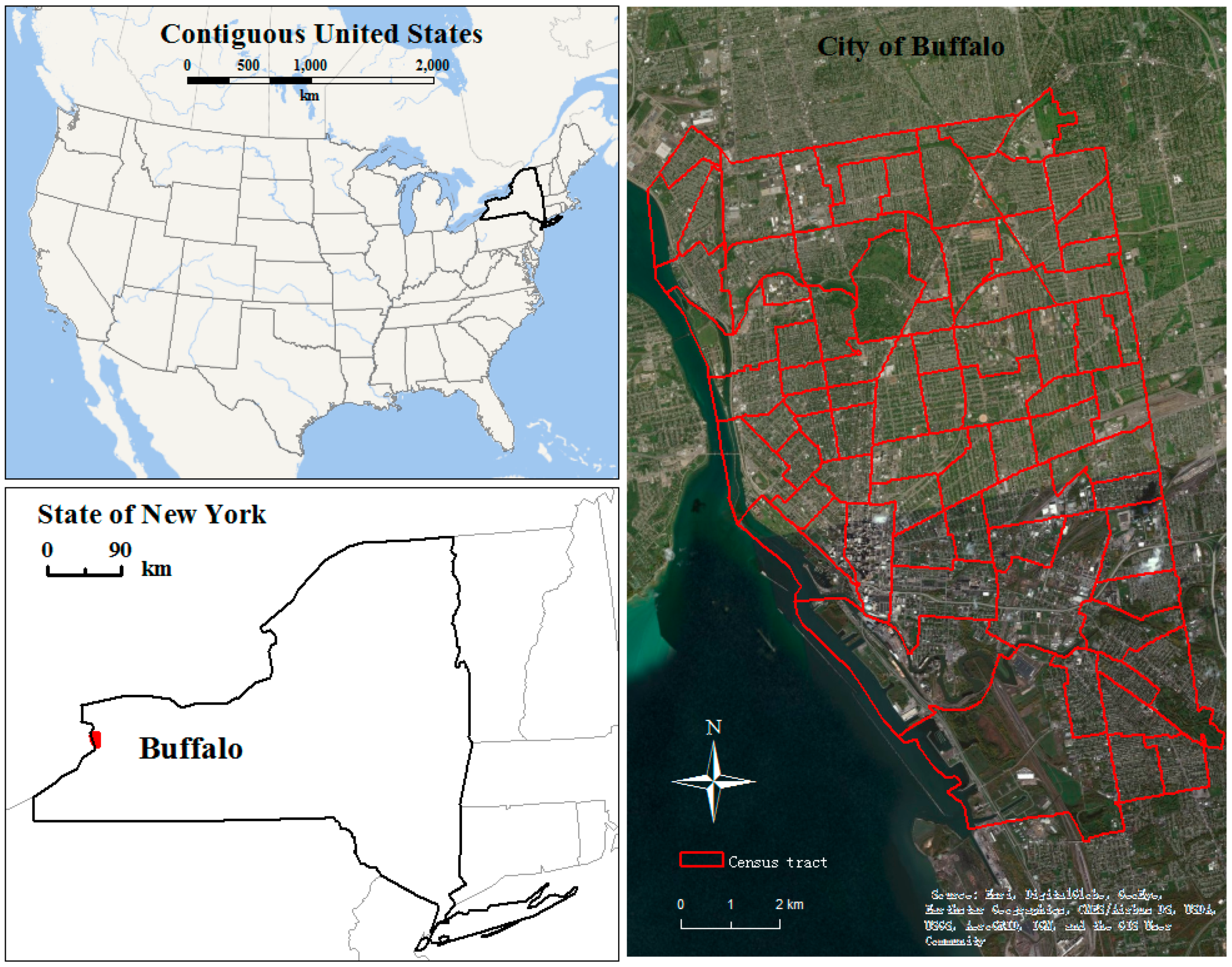
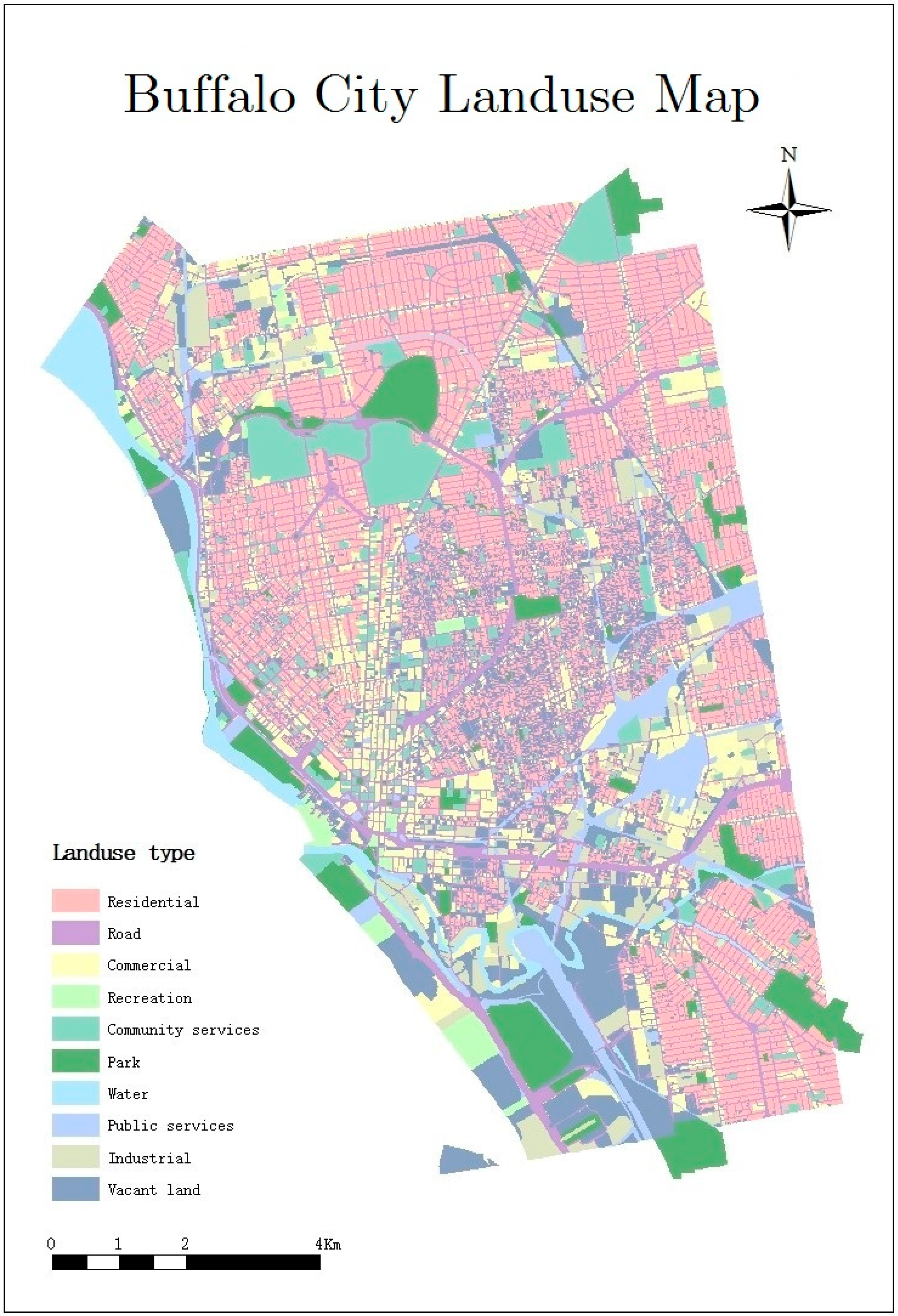
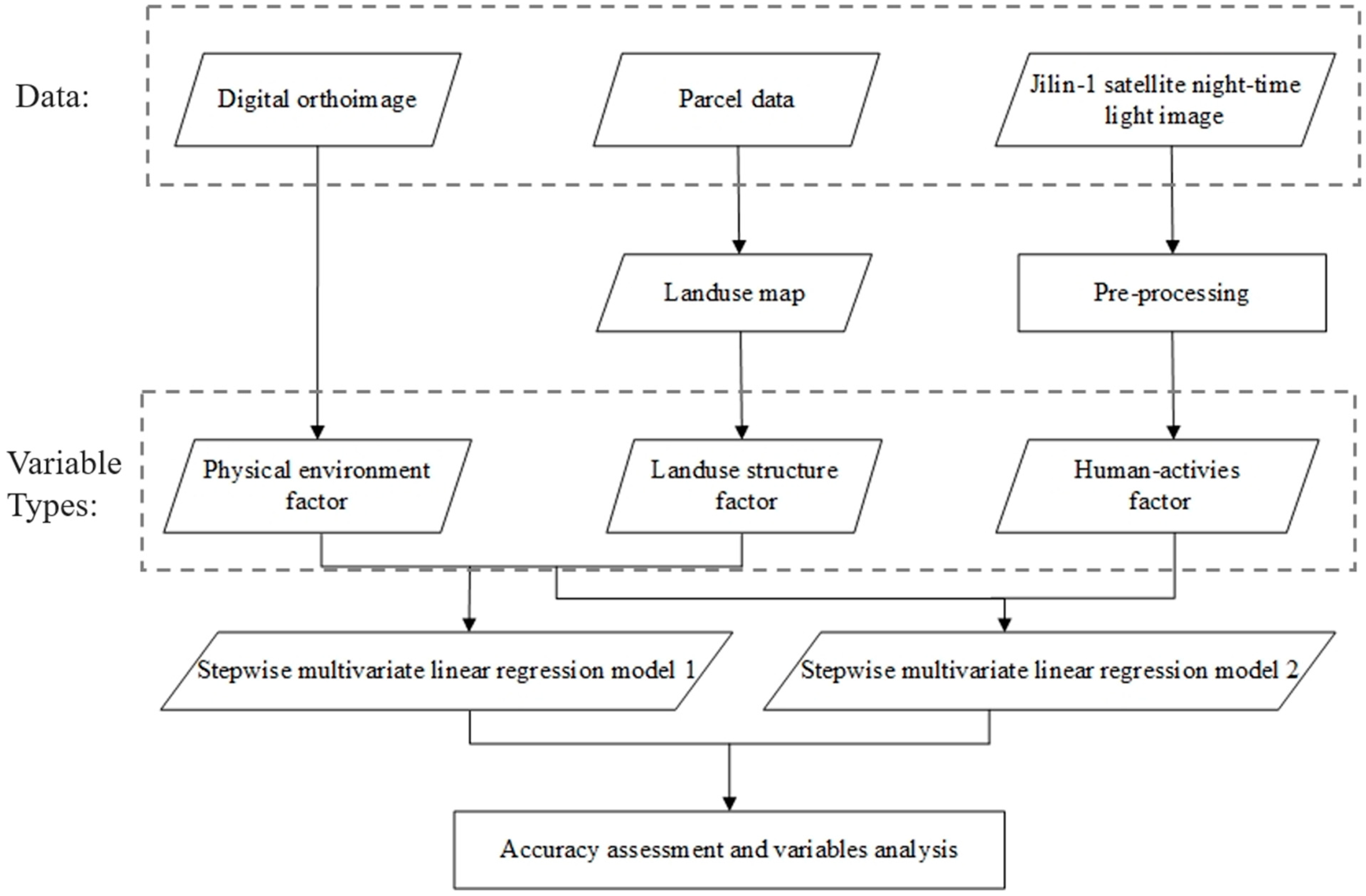
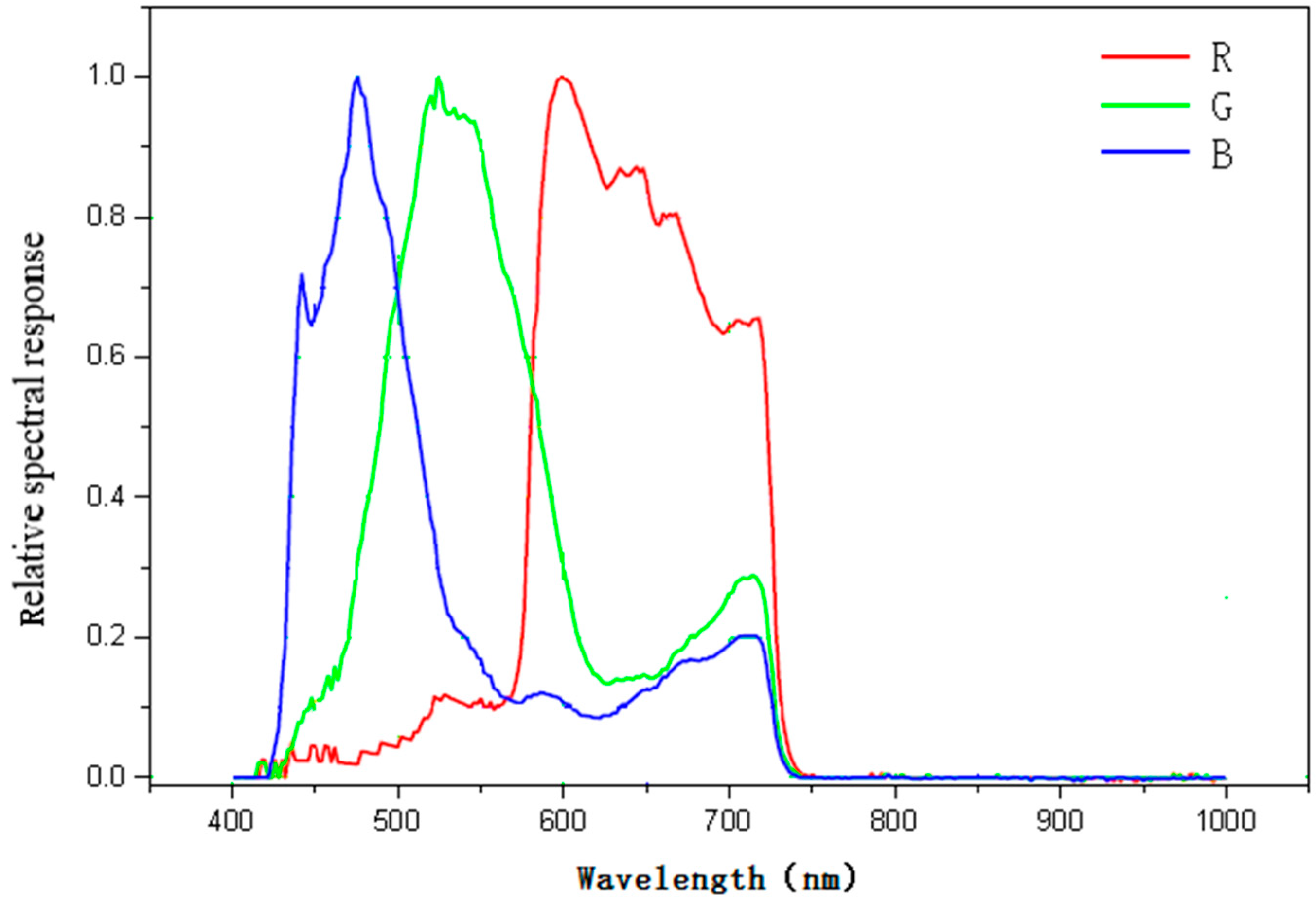
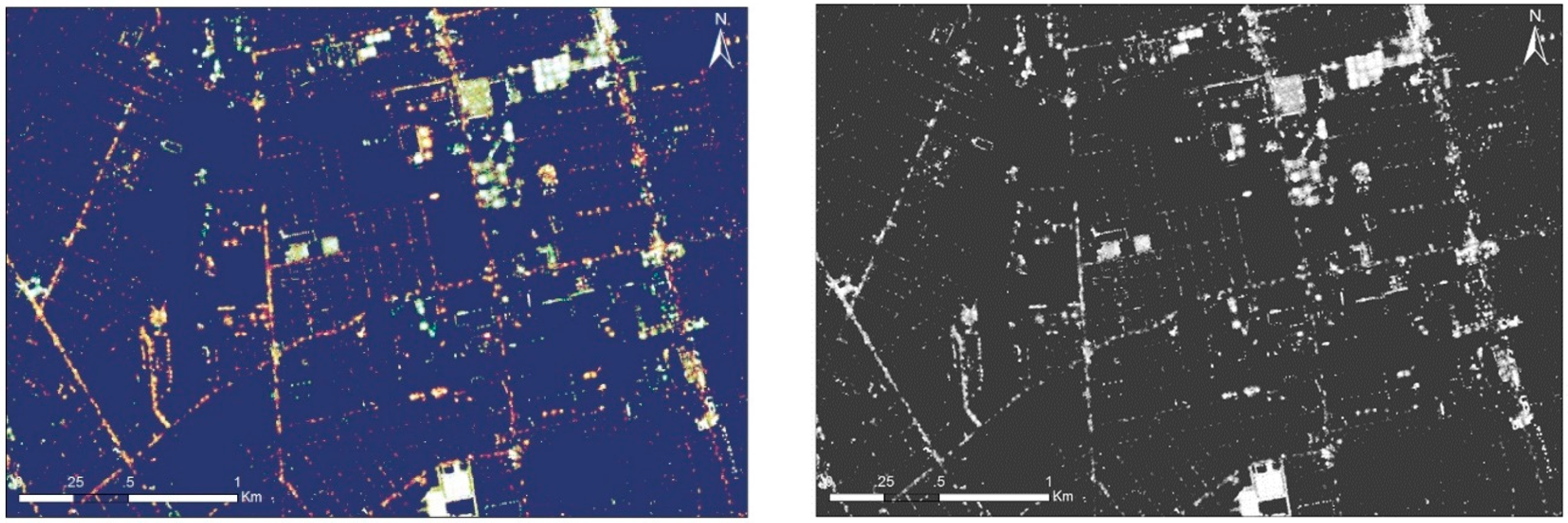
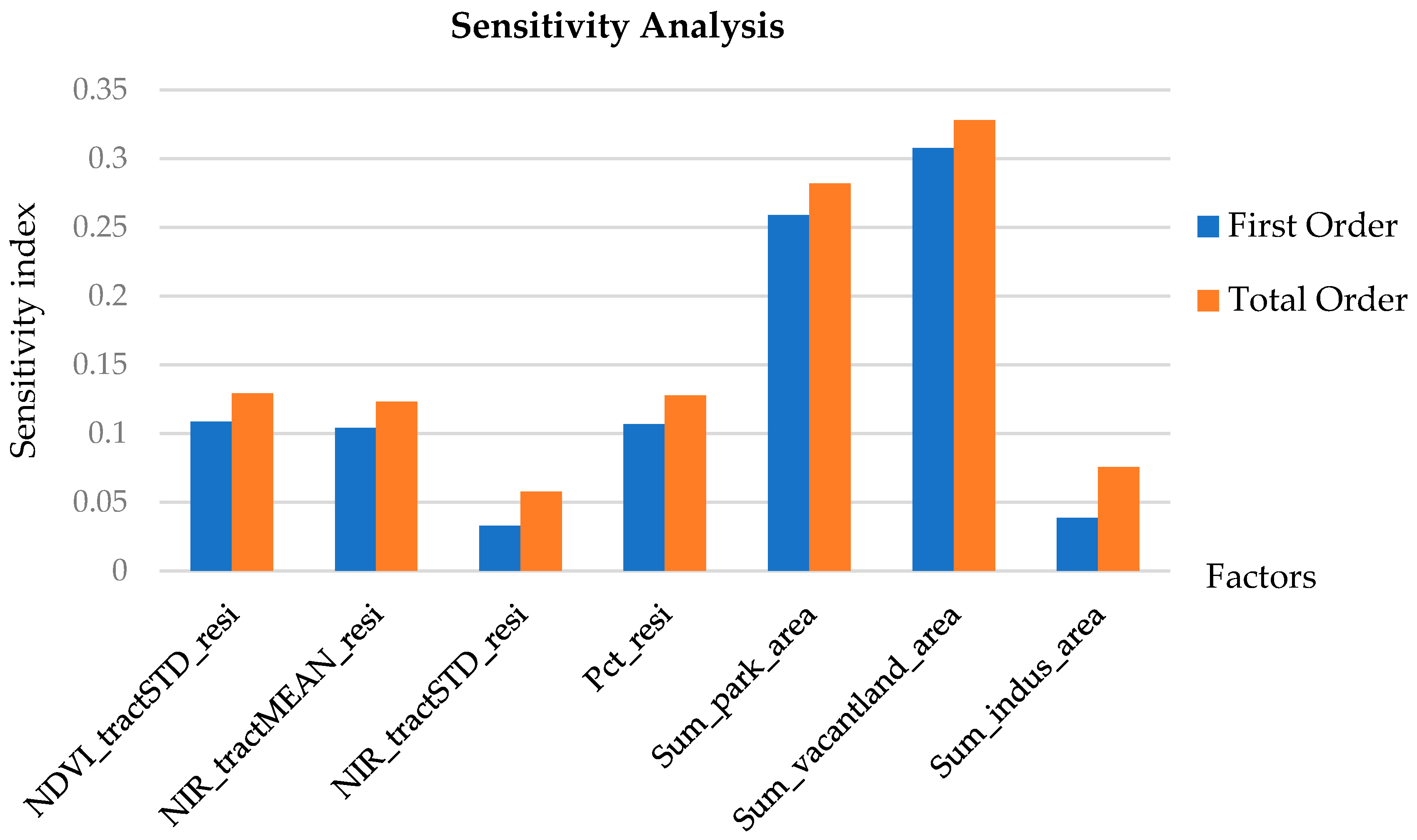
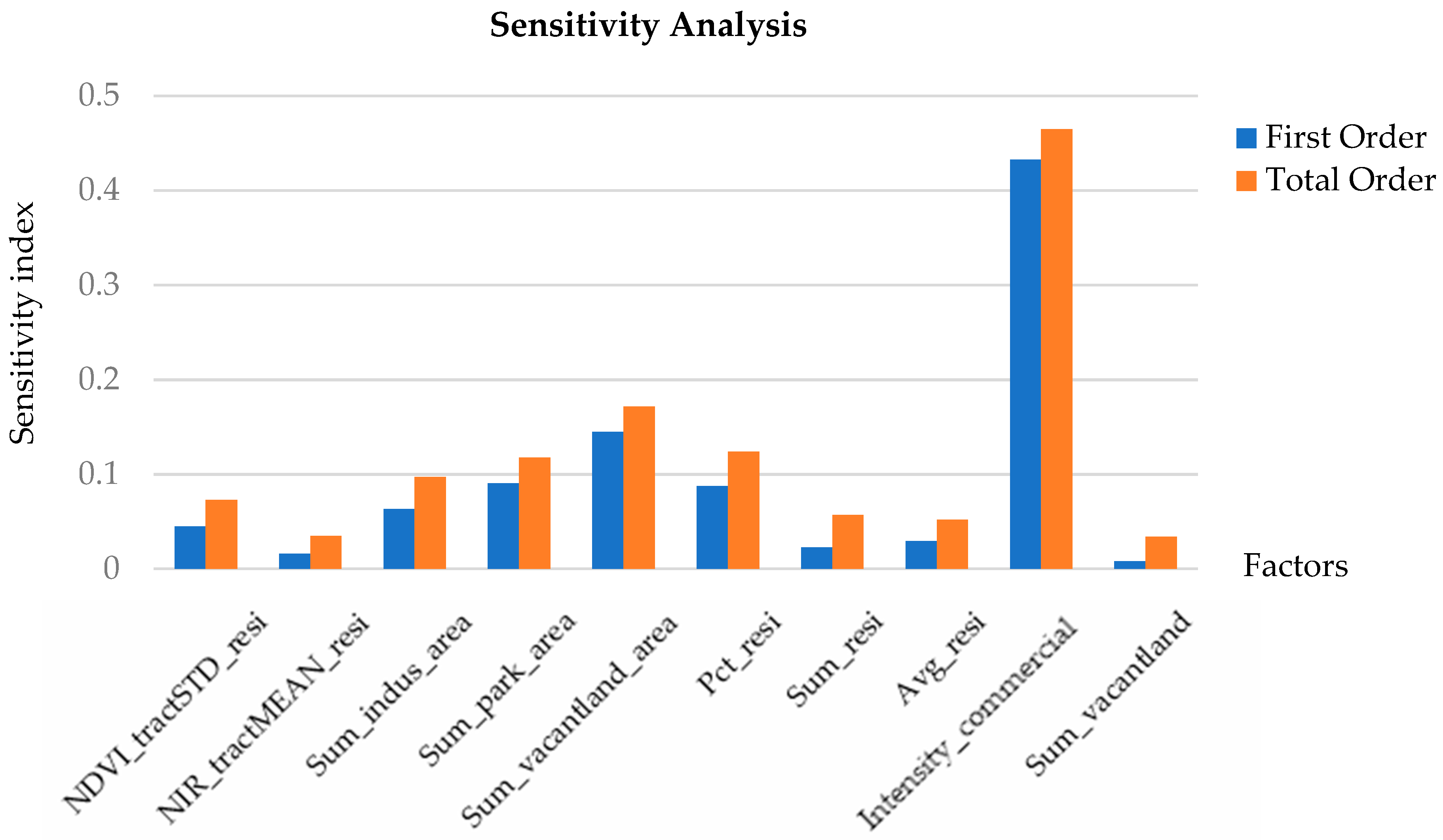
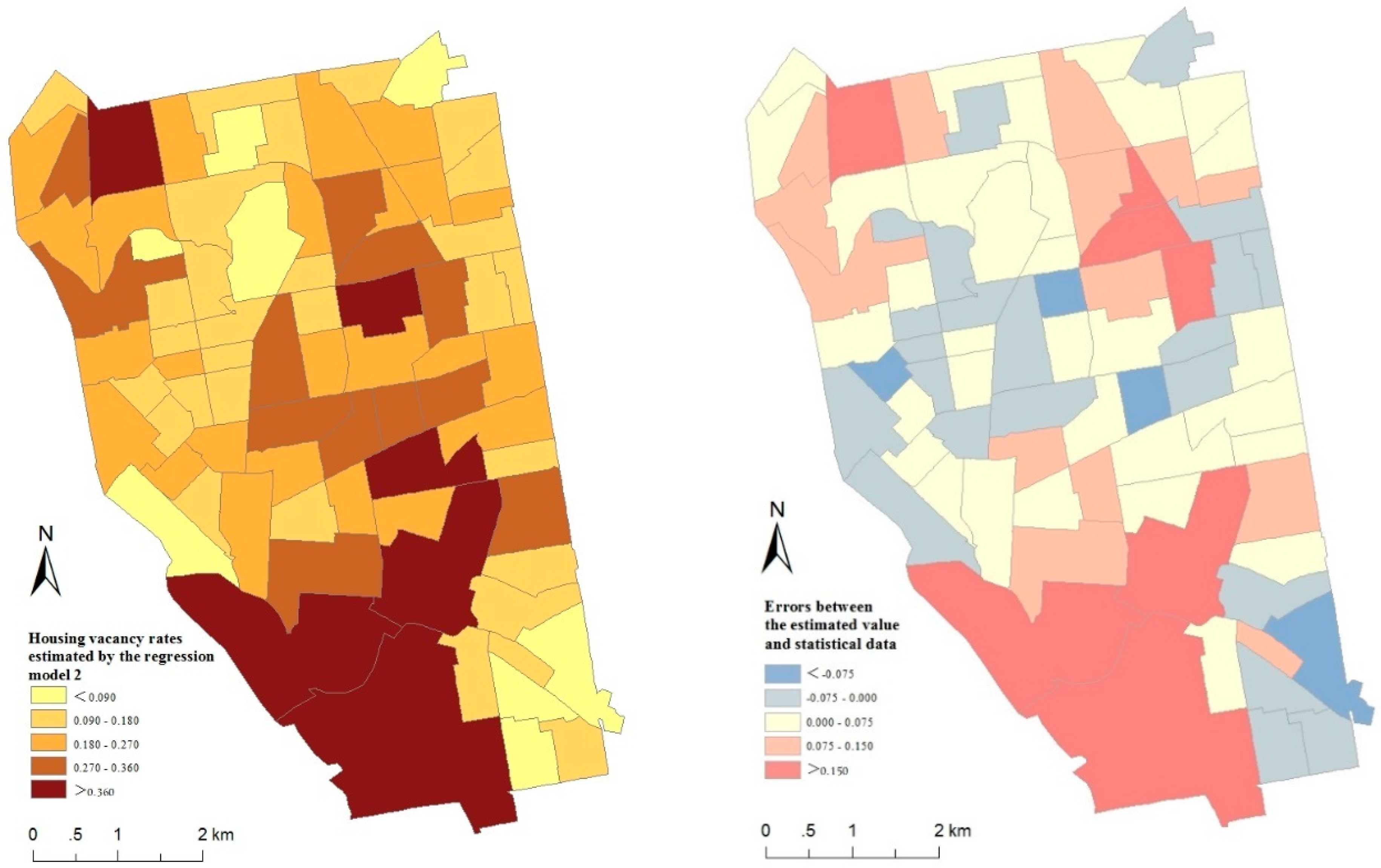
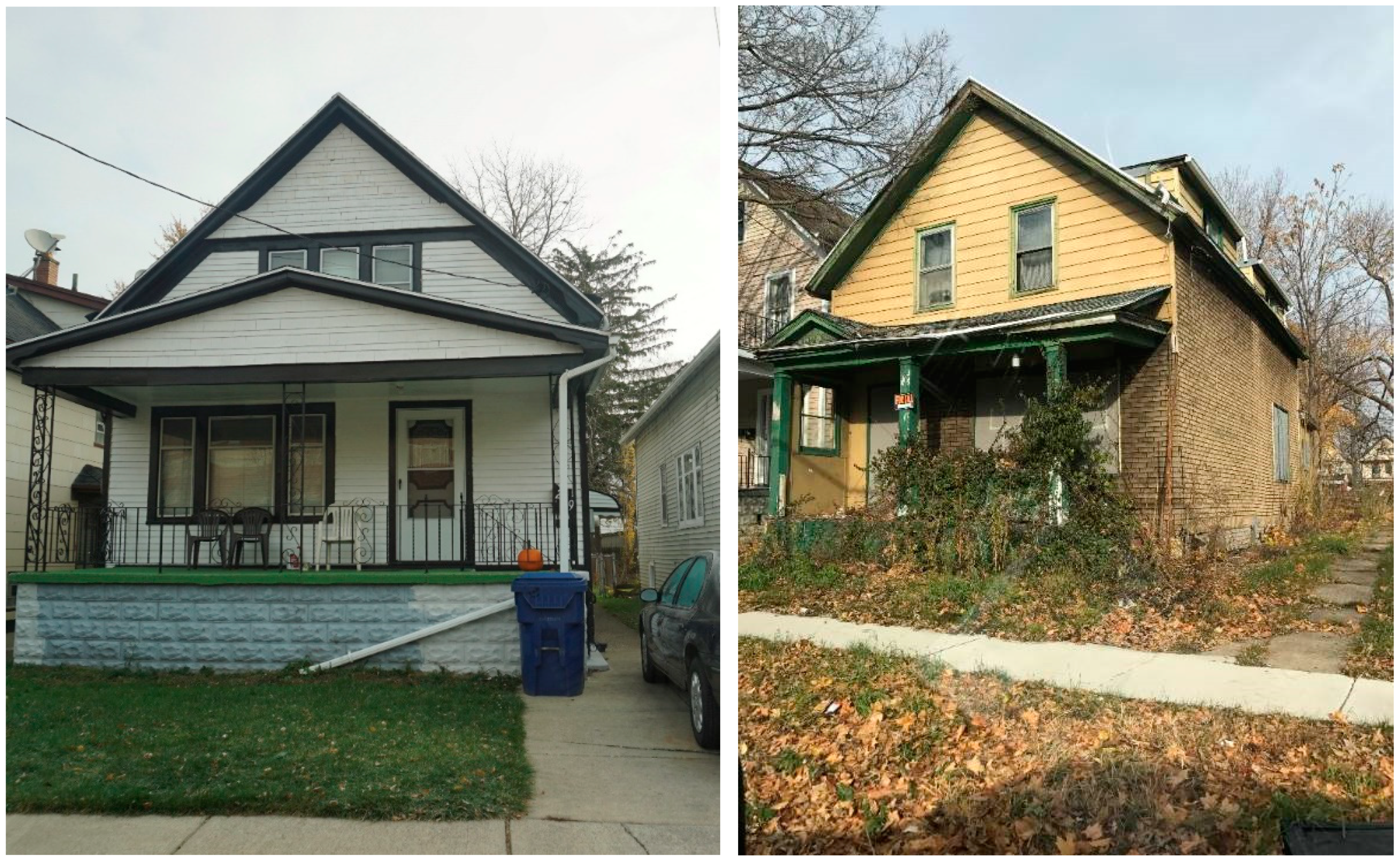
| Parameters | DMSP/OLS | NPP/VIIRS | Jilin1-03 Commercial Satellite |
|---|---|---|---|
| Platform operator | U.S. Air Force | NOAA/NASA | Changguang Satellite Technology Co., Ltd |
| Data producer | NOAA/NCEI (former NGDC) | NOAA/NCEI | Changguang Satellite Technology Co., Ltd |
| Launch year | 1976 | 2011 | 2017 |
| Orbital height/km | 850 | 827 | 535 |
| Spatial resolution/m | 1000 | 375 | 0.94 |
| Grey quantization level/bit | 8 | 14 | 8 |
| Unit | DN | Watt/m2/Sr for swath data, nano-Watt/cm2/Sr for composite data | Watt/m2/Sr |
| Data availability | Annual average NTL products can be downloaded for free. Monthly average and daily products need to be ordered. | Annual and Monthly average NTL products, and some daily mosaic can be downloaded for free. | Need to pay for the order. |
| Parameters | a | b |
|---|---|---|
| R | 9681.000 | −4.730 |
| G | 5455.000 | −3.703 |
| B | 2997.000 | −4.471 |
| Factor Type | Explanatory Variables | Description |
|---|---|---|
| Physical environmental factors from digital orthoimage | NDVI_tractMEAN_resi | Mean NDVI in residential area |
| NDVI_tractSTD_resi | Standard deviation NDVI in residential area | |
| NIR_tractMEAN_resi | Mean value of NIR band in residential area | |
| NIR_tractSTD_resi | Standard deviation of NIR band in residential area | |
| R_tractMEAN_resi | Mean value of R band in residential area | |
| R_tractSTD_resi | Standard deviation of R band in residential area | |
| Landuse structure factors from parcel data | Sumarea_landusetype | Area of residential/commercial/recreation/ road/community services/public services/industrial/park/vacant land |
| CensusTract_area | Area of the census tract | |
| Pctarea_resi | Percentage area of residential in a census tract | |
| Countparcel_resi | Housing units in residential area | |
| Human activity factors from Jilin1-03 satellite NTL image (new added in model 2) | Sum_landuse type | Sum brightness of residential/commercial/recreation/ road/community services/public services/industrial/park/vacant land |
| Avg_landusetype | Average brightness of residential/commercial/recreation/ road/community services/public services/industrial/park/vacant land | |
| Litarea_landuse type | Lit areas of residential/commercial/recreation/ road/community services/public services/industrial/park/vacant land | |
| Intensity_landuse type | luminous intensity of residential/commercial/recreation/ road/community services/public services/industrial/park/vacant land |
| Factor Type | Explanatory Variables | Coefficient | Normalized Coefficient | p-Value | Tolerance | VIF |
|---|---|---|---|---|---|---|
| Physical environmental factors | Constant | 1.023 | ||||
| NDVI_tractSTD_resi | −0.100 | −0.452 | 3.403 × 10−5 *** | 0.620 | 1.613 | |
| NIR_tractMEAN_resi | −0.002 | −0.544 | 2.069 × 10−6 *** | 0.586 | 1.707 | |
| NIR_tractSTD_resi | −0.004 | −0.216 | 1.711 × 10−2 * | 0.826 | 1.211 | |
| Landuse structure factors | Pct_resi | −0.191 | −0.418 | 4.033 × 10−5 *** | 0.709 | 1.411 |
| Sum_park_area | −0.000 | −0.725 | 9.853 × 10−8 *** | 0.434 | 2.303 | |
| Sum_vacantland_area | 0.000 | 0.860 | 6.414 × 10−6 *** | 0.208 | 4.804 | |
| Sum_indus_area | −0.000 | −0.364 | 1.209 × 10−2 ** | 0.323 | 3.092 |
| Factor Type | Explanatory Variables | Coefficient | Normalized Coefficient | p-Value | Tolerance | VIF |
|---|---|---|---|---|---|---|
| Physical environmental factors | Constant | 0.896 | ||||
| NDVI_tractSTD_resi | −1.128 | −0.511 | 4.860 × 10−7 *** | 0.568 | 1.762 | |
| NIR_tractMEAN_resi | −0.002 | −0.392 | 1.786 × 10−4 *** | 0.487 | 2.055 | |
| Landuse structure factors | Pct_resi | −0.349 | −0.747 | 1.103 × 10−9 *** | 0.432 | 2.315 |
| Sum_park_area | −0.000 | −0.774 | 4.496 × 10−10 *** | 0.427 | 2.339 | |
| Sum_vacantland_area | 0.000 | 1.095 | 8.960 × 10−8 *** | 0.144 | 6.963 | |
| Sum_indus_area | −0.000 | −0.589 | 2.670 × 10−5 *** | 0.279 | 3.582 | |
| Human activity factors | Avg_resi | −3338.169 | −0.516 | 9.146 × 10−5 *** | 0.309 | 3.234 |
| Sum_resi | 0.005 | 0.348 | 8.501 × 10−3 ** | 0.287 | 3.348 | |
| Sum_vacantland | 0.000 | −0.301 | 3.376 × 10−3 ** | 0.482 | 2.077 | |
| Intensity_commercial | −16.135 | −2.000 | 9.192 × 10−3 ** | 0.852 | 1.174 |
© 2018 by the authors. Licensee MDPI, Basel, Switzerland. This article is an open access article distributed under the terms and conditions of the Creative Commons Attribution (CC BY) license (http://creativecommons.org/licenses/by/4.0/).
Share and Cite
Du, M.; Wang, L.; Zou, S.; Shi, C. Modeling the Census Tract Level Housing Vacancy Rate with the Jilin1-03 Satellite and Other Geospatial Data. Remote Sens. 2018, 10, 1920. https://doi.org/10.3390/rs10121920
Du M, Wang L, Zou S, Shi C. Modeling the Census Tract Level Housing Vacancy Rate with the Jilin1-03 Satellite and Other Geospatial Data. Remote Sensing. 2018; 10(12):1920. https://doi.org/10.3390/rs10121920
Chicago/Turabian StyleDu, Mingzhu, Le Wang, Shengyuan Zou, and Chen Shi. 2018. "Modeling the Census Tract Level Housing Vacancy Rate with the Jilin1-03 Satellite and Other Geospatial Data" Remote Sensing 10, no. 12: 1920. https://doi.org/10.3390/rs10121920
APA StyleDu, M., Wang, L., Zou, S., & Shi, C. (2018). Modeling the Census Tract Level Housing Vacancy Rate with the Jilin1-03 Satellite and Other Geospatial Data. Remote Sensing, 10(12), 1920. https://doi.org/10.3390/rs10121920





